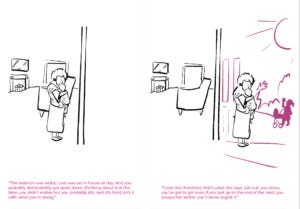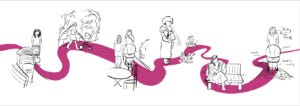I produced a write up of the funded project for the Leisure Studies Association who made the work possible through their grant scheme. This also offers a more detailed look at what underpins the work so far.
I have been a member of the LSA for about 10 years now and served on the committee. I am really proud to have been awarded a small grant from them to expand this work and I encourage any scholars working on leisure related topics to join!
Though walking with a baby as a mother may seem mundane, it is an emotionally and logistically complex practice (Clement and Waitt, 2018) further compounded during the lockdown restrictions in Manchester, UK through 2020/2021. This project, inspired by time-geography (Hägerstrand, 1982) as method, examined how diagramming in comic book form (Carruthers Thomas, 2018) might facilitate a more substantive understanding of walking as a distinctive, spatiotemporal experience of mothering. Feminist geographers argue that applications of time-geography do not account for embodied gendered power relations in space (Rose, 1993). Drawing on interviews with women who walked with their babies during the pandemic as well as autoethnographic diaries and images of the presenters own walking experiences, the aim was to not only use the comic book form as a user-friendly method of research dissemination but also as methodology particularly to experiment with sequence, simultaneity, and subjectivities (Kuttner, Weaver-Hightower and Sousanis, 2021) to examine the gendered spatio-temporal relations revealed through leisure and walking practices for mothers.
The initial outcome of this work can be found here (this phase of work was funded by Manchester Metropolitan University Business Transformations Research Centre):
An extension of this work was then made possible through the Leisure Studies Association Research and Enterprise Development Fund. Walking is often framed as a masculine pursuit, where the male body has freedom to wander landscapes unencumbered. However, walking is a risky activity for women and walking with infants further complicates this. Therefore, when considering walking as a leisured activity for women and their children a nuanced perspective is required to develop solutions for enhancing wellbeing. Further, mothers’ leisure that integrates their children is little considered in leisure studies literature and leisure conceptualised as happening ‘away’ from the child (Hybholt et al, 2021; O’Brien et al, 2017). This project was broadly about what counts as leisure and how might walking spaces be made more leisurely for walking mums (and their infants). Walking with children and babies is under researched and often framed through mobilities rather than leisure specifically (Clement and Waitt, 2017 & 2018). Leisure by mothers is often framed as something that can only happen away from their child(ren) leaving a gap in the literature for exploring (Hybholt et al, 2021; O’Brien et al, 2017). Considering how the presence babies who are very dependent on their care-giver impacts on a leisured experience is little researched.
Further, there has been an increased interest in wellbeing and leisure and this project contributes to these discussions. What counts as leisure and wellbeing needs further interrogation to feed into policy discussions (Mansfield, 2021). In relation to walking specifically, it is a practice often romanticised (Middleton, 2021) and there is an assumption that it is positive for one’s mental and physical wellbeing. This assumption can lead to problematic conclusions and policy decisions which do not account for a diversity of experiences. For example, walking with a baby presents spatial challenges which can make a walk difficult and uncomfortable rather than a positive experience. This is particularly important in the context of perinatal mental health, an area also under-researched in leisure scholarship. However, as the manifesto demonstrates, if spaces are not accessible for walking mums then the mental and physical health benefits cannot be felt.
This manifesto was built from reflections provided by walking mums from around the UK and Ireland during Autumn 2022 and by taking a walk with a group of mums with their infants in Prestwich, Manchester in Nov 2022. The joy of this manifesto is found in the contradictions – walks with infants change as our children grow; as our bodies heal and we become stronger. The walk changes with the seasons and changes due to the constraints of the spaces we walk through.
The work will now be developed into a symposium to bring together academics, policy-makers charities, activists and community organisations. The aim will be to explore walking with children more broadly and potential place-based solutions.
For more about this project please see:
www.walkingwithinfants.blogspot.com
The illustrations were created by:
References
Carruthers Thomas, K. (2018, December 3). Getting Graphic … Ways of Thinking [Online]. The Sociological Review. https://thesociologicalreview.org/collections/graphic-social-science/getting-graphicways-of-thinking/
Clement, S and Waitt, G (2018) Pram mobilities: Affordances and atmospheres that assemble childhood and motherhood on-the-move. Children’s Geographies 16(3). 252–265.
Clement, S and Waitt, G (2017) Walking, mothering and care: A sensory ethnography of journeying on-foot with children in Wollongong, Australia. Gender, Place & Culture 24(8). 1185–1203.
Hägerstrand, T. (1982). Diorama, path and project. Tijdschrift voor economische en sociale geografie, 73(6), 323-339.
Hybholt, M., Ottesen, L.S. and Thing, L.F. (2021) Exercise in the time bind of work and family. Emotion management of personal leisure time among middle-aged Danish women. Leisure Studies 0(0). 1–16. DOI: 10.1080/02614367.2021.1975801.
Kuttner, P.J., Weaver-Hightower, M.B. and Sousanis, N. (2021) Comics-based research: The affordances of comics for research across disciplines. Qualitative Research 21(2). 195–214.
Mansfield, L. (2021). Leisure and health–critical commentary. Annals of Leisure Research, 24(3), 283-294.
Middleton, J. (2021). The walkable city: Dimensions of walking and overlapping walks of life. Routledge.
O’Brien, W., Lloyd, K. and Riot, C. (2017) Exploring the emotional geography of the leisure time physical activity space with mothers of young children. Leisure Studies 36(2). 220–230.
Rose, G. (1999) Women and Everyday Spaces. In: Price J and Shildrick M (eds) Feminist Theory and the Body: A Reader. Edinburgh: Edinburgh University Press, pp. 359–370.




